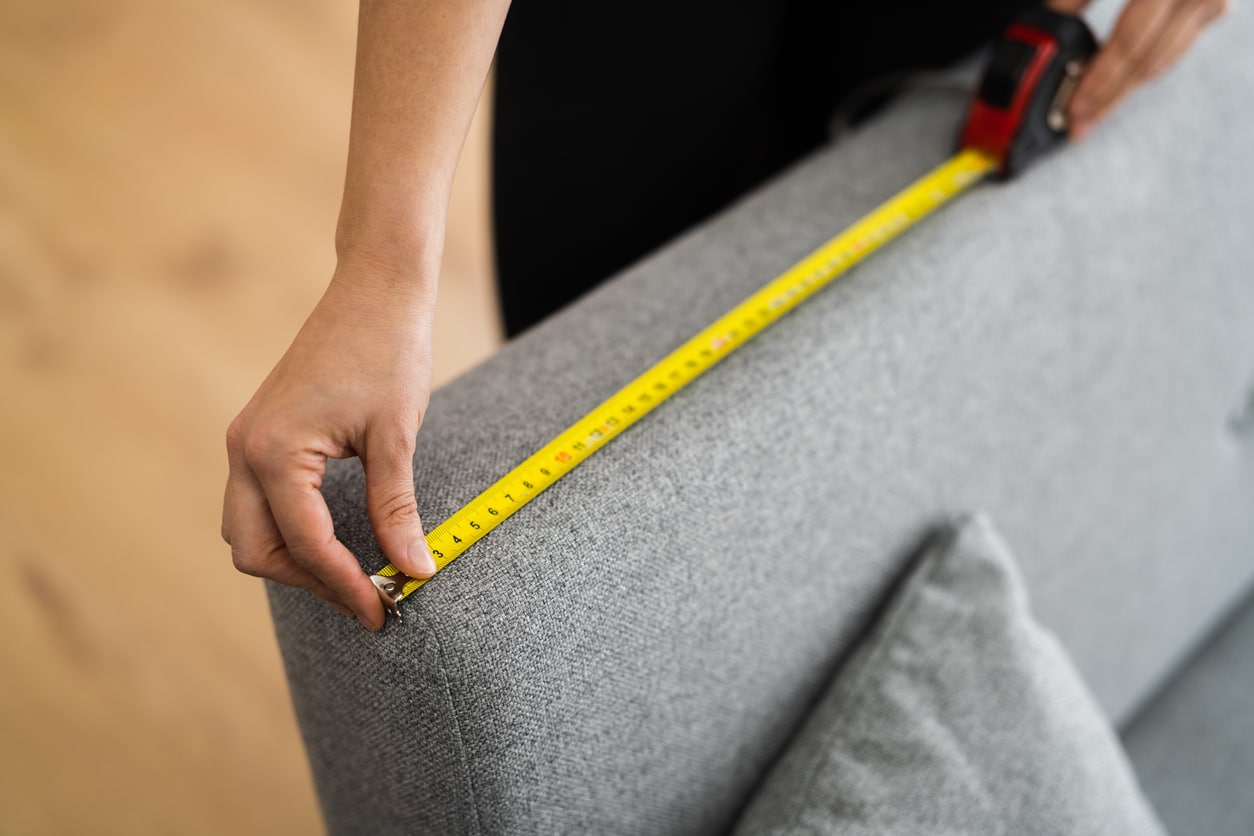Let’s be honest: hiring a moving company to handle your couch is the easiest way to go. They show up, lift the thing like it’s a pillow, and whisk it away without a scratch.
But sometimes, you want to take the job on yourself. Maybe you want to save some money, or maybe you just like the challenge.
This guide will walk you through how to move a couch the right way — with the right supplies, smart planning, and clear, step-by-step instructions. By the end, you’ll know exactly what it takes to pull off a DIY couch move safely and confidently.
How to Move a Couch By Yourself
Before you even think about lifting that couch, you need the right gear. Moving a couch is all about preparation. The right supplies will make the difference between a smooth move and a scratched floor, dented wall, or wrenched back.
Supplies for moving a couch
Add these details to your moving checklist. Here’s what you need.
Measuring tape: You’ll need this to check the dimensions of the couch, doorways, hallways, and stairwells. A quick measure can save you from getting stuck halfway through a door and avoid a pivot situation.
Moving straps: These padded straps help distribute the weight of a heavy couch and reduce the strain on your back. They’re especially useful for moving larger or bulkier couches with a friend.
Furniture sliders: Sliders let you glide a couch across hardwood, tile, or carpet without damaging the floor. Choose the right type for your surface — hard plastic for carpet, soft felt for hard floors.
A buddy: Teamwork makes the dream work. Even if you plan to tackle most of the move yourself, having an extra set of hands can help steady the couch and make tough corners easier to manage.
Dolly or hand truck: For especially heavy or bulky couches, a dolly can be a lifesaver. It lets you roll the weight instead of lifting it and works well on flat surfaces or ramps.
Moving blankets or plastic wrap: Use blankets or wrap to protect the upholstery from dirt, scratches, or snags during the move. This will also help shield the couch if it brushes against walls or door frames.
Screwdriver or allen wrench: If you need to disassemble legs, armrests, or other pieces, you’ll want the right tools ready. Keep a small plastic bag nearby to collect screws and bolts.

Measuring
Before you lift or slide anything, you need to know if your couch will even fit through the path you’ve planned. Measuring is one of the most important steps you can take. It helps you figure out if you’ll need to disassemble the couch, remove a door, or grab extra tools.
Measure your couch
Start with the couch itself. Knowing its full dimensions will tell you if you have a chance of getting it through doors or hallways without taking it apart.
Measure the width: This is the distance across the widest part of the couch, usually from arm to arm.
Measure the height: Check from the floor to the tallest point, often the backrest.
Measure the depth: This is the distance from the front edge of the seat to the back edge.
If the couch has removable parts (like legs or cushions), measure again with those removed — it may give you just enough clearance.
Measure doorways and stairwells
Next, measure the spaces you’ll be navigating. This ensures you won’t get stuck halfway through or damage walls and trim (and have to give that deposit back).
Measure the width of the doorway: From one inside edge to the other, accounting for any trim or molding.
Measure the height of the doorway: From the floor to the top inside edge of the frame.
For stairwells, measure the width of the stairs and the height of the ceiling above them to see if the couch can be angled or pivoted through.
Check for tight turns or corners where you might need extra clearance.
Pro Tip: Looking to plan your move on your own? Check out these moving apps to make your life easier. |

Protecting your couch and your home
Moving a couch is more than getting it from point A to point B. With such a clunky piece of furniture, you must make sure it (and your space) remain unharmed.
This makes it critical to take the time to wrap the couch properly and prepare your home to avoid dents, scratches, or broken fixtures along the way.
How to wrap a couch for moving
Protecting your couch is key to keeping it in good shape. Here’s how to do it right:
Remove cushions and pillows: Pack them separately in plastic bags or boxes to keep them clean and out of the way.
Wrap the couch in plastic wrap or moving blankets: Cover all surfaces, paying special attention to corners and edges. Use tape or stretch wrap to hold the covering in place.
Secure any loose parts: Tie down removable parts, like recliner handles or detachable legs, or pack them separately and label them.
Check for hidden hazards: Remove staples, sharp legs, or anything that could tear the wrap or scratch floors during the move.
How to protect your home while moving
Your home is just as important to protect as the couch itself. A little prep work will save you from costly repairs.
Wrap sharp corners or door frames: Use blankets or foam padding on tight corners to prevent dings or scratches.
Remove doors if needed: Instead of forcing the couch through, take the door off its hinges to create extra space.
Clear the path: Move fragile items, rugs, or obstacles out of the way before you start.
Lay down protective coverings: Use cardboard or old sheets on floors to avoid scuffs, especially on hardwood or tile.

Steps for moving a couch
Now that you’ve measured, wrapped, and prepped your space, it’s time for the main event: moving the couch. Follow these steps carefully.
Step 1: Make a plan
Decide exactly where the couch is going. Know your path, measure the space, and check for tight corners or tricky turns. Planning ahead saves time and reduces the chance of mid-move surprises.
Step 2: Use furniture straps
Straps help distribute the weight of the couch evenly and take pressure off your back. Make sure the straps are secure and adjusted to your height before lifting.
Step 3: Warm up and lift with your legs
Before you lift, stretch your arms, legs, and back. When you lift, bend your knees and keep your back straight. Let your legs do the heavy work to reduce the risk of injury.
Step 4: Take breaks as needed
Moving a couch isn’t a race. Set it down gently if you need to catch your breath or re-grip. Pushing too hard increases the chance of mistakes or injury.
Step 5: Secure the couch in the truck
If you’re loading the couch onto a moving truck, place it carefully against the wall of the vehicle or another large, stable item. Use ropes or straps to secure it in place so it doesn’t shift in transit.
Special Tips for Moving a Couch
Sometimes, a straightforward lift-and-carry just won’t cut it. Tight spaces, heavy pieces, or tricky angles can make the job harder — unless you know the right techniques. Keep these tips in mind to navigate common challenges.
How to move a couch through a narrow door
Start by comparing your measurements — the couch’s height and width against the doorway’s opening. If it’s close, stand the couch on one end and pivot it carefully, using a “hook and turn” motion to slip it through.
Removing the door from its hinges can also give you extra clearance. And if that’s still not enough, take the couch apart by removing legs or arms, storing the hardware in a small bag taped securely to the underside.
How to move a couch upstairs or downstairs
Moving a couch upstairs calls for patience and teamwork.
Clear the entire path ahead of time, then have one person guide from above and another support from below, communicating constantly. Moving straps will help balance the weight, and a dolly can assist on straight staircases.
No matter the setup, take your time and rest when needed to avoid accidents.

How to move a heavy couch by yourself
Handling a heavy couch solo takes preparation. Here are some helpful tips:
Use furniture sliders to glide the piece across floors and a dolly for longer stretches.
Disassemble any removable parts to lighten the load, keeping all screws and small hardware in a bag taped to the couch.
Even if you’re set on working alone, be sure to have someone nearby for backup if the weight or size becomes unmanageable.
How to move a sectional couch
Sectional couches should always be disassembled before moving. Break them into separate pieces, carefully storing all connectors and screws in a labeled bag taped to one section.
Move each piece individually, treating it like its own smaller couch, to reduce strain and prevent damage to the connecting hardware.
More Pro Packing and Moving Resources: |
.
Your Couch Move, Made Simple
Moving a couch takes preparation, the right supplies, and careful steps. Whether you handle it alone or with help, success comes down to good planning and safe techniques.
If moving your couch is part of a long-distance move, Colonial Van Lines is here to help. With over 50 years of long-distance packing and moving services, we handle couches, furniture, and everything else with expert care. Get a free quote today and let Colonial make your next move smooth and simple.

